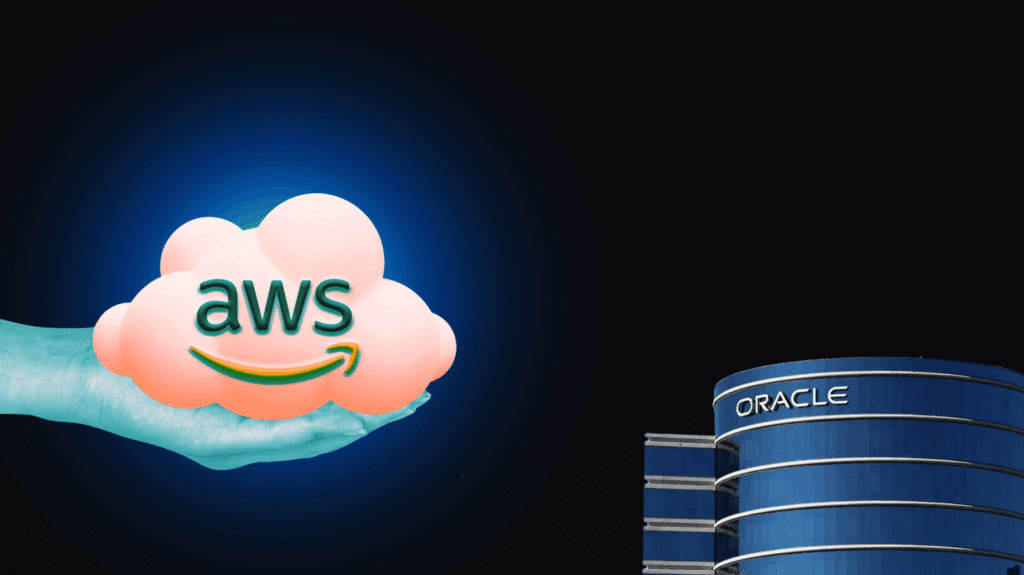Oracle’s Database@AWS Launch Signals Multicloud Pivot While Preserving License Revenue Streams

Oracle’s recent launch of Database@AWS represents a fundamental strategic shift that simultaneously embraces multicloud flexibility while ingeniously preserving the company’s lucrative perpetual licensing model. The general availability announcement, coupled with aggressive Bring Your Own License (BYOL) incentives offering 76% cost savings, reveals a sophisticated approach to maintaining market relevance in an increasingly cloud-native world while protecting Oracle’s $20 billion annual support revenue stream.
A Partnership Born of Pragmatic Necessity
The Oracle Database@AWS offering, now available in AWS’s U.S. East and West regions with plans to expand to 20 additional regions globally, represents the culmination of a strategic partnership announced in September 2024[1]. This collaboration allows enterprises to run Oracle Exadata Database Service and Oracle Autonomous Database on Oracle Cloud Infrastructure hardware physically located within AWS data centers, creating what industry analysts describe as a “first-party” integration that eliminates traditional multicloud complexity.
The technical architecture is particularly noteworthy for its seamless integration approach. Customers can provision Oracle Database@AWS resources using familiar AWS tools including CloudFormation, the AWS Console, and command-line interfaces, while maintaining compatibility with AWS security frameworks, CloudWatch monitoring, and Identity and Access Management systems[2]. This integration extends to data protection, with Oracle-managed backups supporting both Amazon S3 and OCI Object Storage, providing customers with flexible disaster recovery options across cloud boundaries.
The offering includes Oracle Database 23ai with embedded AI Vector Search capabilities, enabling advanced semantic search across structured and unstructured data. When combined with AWS services like Amazon SageMaker, Bedrock, and Redshift, this creates powerful opportunities for enterprises to build AI-driven applications without the traditional complexity of cross-cloud data movement[3].
The Economics of Perpetual License Preservation
Perhaps the most strategically significant aspect of Oracle Database@AWS is the company’s aggressive promotion of BYOL arrangements over subscription models. According to licensing experts, Oracle is actively incentivizing customers to utilize existing perpetual licenses rather than adopting cloud-native subscription pricing, with BYOL offering a remarkable 76% reduction in Autonomous Database compute costs compared to license-included alternatives[4].
Eric Guyer, founding partner at Oracle and SAP advisory firm Remend, observed that “Oracle still prefers customers go out and either bring, or even buy net new, traditionally licensed perpetual software, even in their own cloud, even in Database@Azure or AWS”[5]. This preference reflects Oracle’s determination to preserve what Guyer characterizes as the company’s “$20 billion per year of annual support payments among the global customer base,” which generates approximately 90% profit margins and represents “just free cash” flow that Oracle wants to maintain indefinitely[6].
The BYOL strategy becomes even more compelling when considering that most Oracle enterprise customers already own sufficient licenses to avoid the license-included model entirely. As Guyer noted, “Most of Oracle’s customers already own enough software, especially the bigger ones. They already own enough software that they don’t need to do the ‘license included’ model. It’s a remarkable difference”[7].
Multicloud Strategy Meets AI Transformation
Industry analysts view Oracle Database@AWS as a critical component of the company’s broader multicloud strategy, which now encompasses partnerships with all three major hyperscalers. Brad Shimmin of Futurum Group characterized the launch as “an important milestone in the Oracle-AWS multicloud partnership” that enables businesses to run critical Oracle workloads without rebuilding applications or creating complex integration points[8].
The strategic implications extend beyond simple cloud portability. As Shimmin noted, “GenAI becomes truly useful only when infused with an organization’s data. That’s when it starts yielding contextually relevant and more accurate responses”[9]. Oracle Database@AWS addresses this need by enabling enterprises to combine their internal Oracle data with large language models via Amazon Bedrock and other AWS AI services, all running within the same data center to minimize latency and maximize performance.
This AI-centric approach is already resonating with early adopters across regulated industries. Fidelity Investments, Nationwide, and SAS have emerged as prominent early customers, with each organization citing specific benefits aligned with their digital transformation strategies. Joe Frazier, head of architecture and engineering at Fidelity Investments, emphasized the importance of maintaining “enterprise-grade resilience” while achieving “cloud agility and performance”[10].
Addressing Historical Cloud Tensions
The Oracle-AWS partnership represents a remarkable evolution in the relationship between two companies that were previously positioned as adversaries. Amazon’s consumer business famously completed its migration away from Oracle databases in 2019, with the company reporting cost savings of up to 90% by switching to AWS-native database services[11]. This high-profile migration became a symbol of the broader industry trend away from traditional Oracle licensing models.
However, the Database@AWS offering acknowledges a more nuanced market reality. While many organizations have successfully migrated away from Oracle for new applications, a substantial installed base of mission-critical Oracle workloads remains deeply embedded in enterprise infrastructure. Nick Walter, CTO and vice president of licensing advisory firm House of Brick, noted that Oracle Database@AWS introduces “interesting licensing scenarios” because it operates under OCI cloud licensing rules rather than AWS licensing terms, potentially providing “more favorable licensing metrics and possibly free usage of some add-ons options/packs for Oracle Database Enterprise Edition”[12].
Strategic Implications for Enterprise IT
The Database@AWS launch signals Oracle’s recognition that customer cloud preferences have fundamentally shifted, with many enterprises standardizing on AWS for their primary cloud infrastructure. Rather than forcing customers to choose between Oracle’s database technology and their preferred cloud platform, the company has opted to meet customers where they are while preserving its core revenue streams.
This approach reflects what Shimmin describes as Oracle’s “redefinition of multicloud,” where Oracle Database runs directly within AWS, Azure, and Google Cloud rather than requiring complex cross-cloud connectivity[13]. The strategy enables Oracle to compete effectively in accounts that have standardized on non-Oracle cloud platforms while maintaining the technical advantages of its optimized Exadata hardware and advanced database features.
The zero-ETL integration capabilities are particularly significant for enterprises seeking to modernize their analytics and AI capabilities. By eliminating the need to build and manage complex data pipelines between Oracle databases and AWS analytics services, the offering reduces both technical complexity and operational overhead while enabling real-time data integration scenarios that were previously difficult to achieve[14].
Market Response and Future Outlook
Early market response to Oracle Database@AWS has been positive, particularly among enterprises in highly regulated industries that require both Oracle’s database capabilities and AWS’s global infrastructure scale. The offering addresses a specific market need for organizations that have made substantial investments in Oracle database technology but prefer AWS for their cloud infrastructure standardization.
The success of this model will likely influence Oracle’s approach to similar partnerships with other hyperscalers. The company has already announced comparable offerings with Microsoft Azure and Google Cloud, suggesting a comprehensive multicloud strategy designed to preserve Oracle’s database market position regardless of customers’ cloud platform preferences.
As enterprises continue to navigate the complexities of digital transformation while managing existing technology investments, Oracle Database@AWS represents a pragmatic solution that balances innovation with continuity. The offering’s emphasis on preserving existing license investments while enabling cloud modernization may prove to be a template for how traditional enterprise software vendors adapt to the cloud-native era without abandoning their core revenue models.
The ultimate test of this strategy will be whether Oracle can maintain its database market leadership while customers increasingly adopt cloud-native alternatives. By making Oracle databases more accessible within customers’ preferred cloud environments, the company has positioned itself to compete more effectively in the evolving enterprise technology landscape while protecting the financial foundation that has sustained its business model for decades.
References
[1] Oracle. “Oracle Database@AWS Now Generally Available.” July 8, 2025. https://www.oracle.com/news/announcement/oracle-database-at-aws-now-generally-available-2025-07-08/
[2] Ibid.
[3] Ibid.
[4] The Register. “Oracle sugars BYOL deals as AWS database tie-in goes live.” July 18, 2025. https://www.theregister.com/2025/07/18/oracle_database_aws/
[5] Ibid.
[6] Ibid.
[7] Ibid.
[8] Futurum Group. “Oracle Database@AWS Rollout Deliver Multicloud Synergies.” July 10, 2025. https://futurumgroup.com/insights/oracle-and-aws-deliver-multicloud-synergies-with-oracle-databaseaws-rollout/
[9] Ibid.
[10] Oracle. “Oracle Database@AWS Now Generally Available.” July 8, 2025.
[11] The Register. “Oracle sugars BYOL deals as AWS database tie-in goes live.” July 18, 2025.
[12] Ibid.
[13] Futurum Group. “Oracle Database@AWS Rollout Deliver Multicloud Synergies.” July 10, 2025.
[14] Oracle. “Oracle Database@AWS Now Generally Available.” July 8, 2025.









